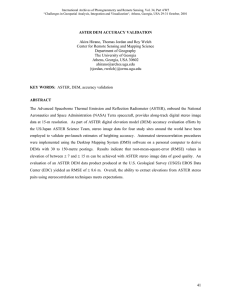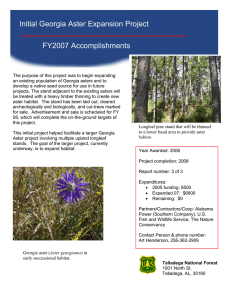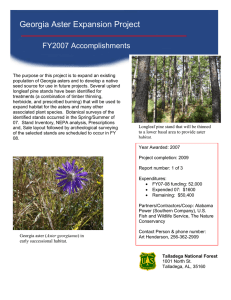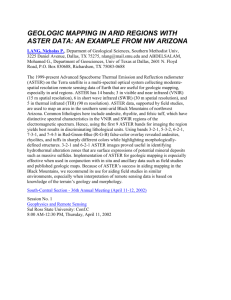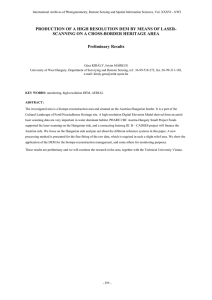Research Journal of Environmental and Earth Sciences 4(12): 1033-1037, 2012
advertisement
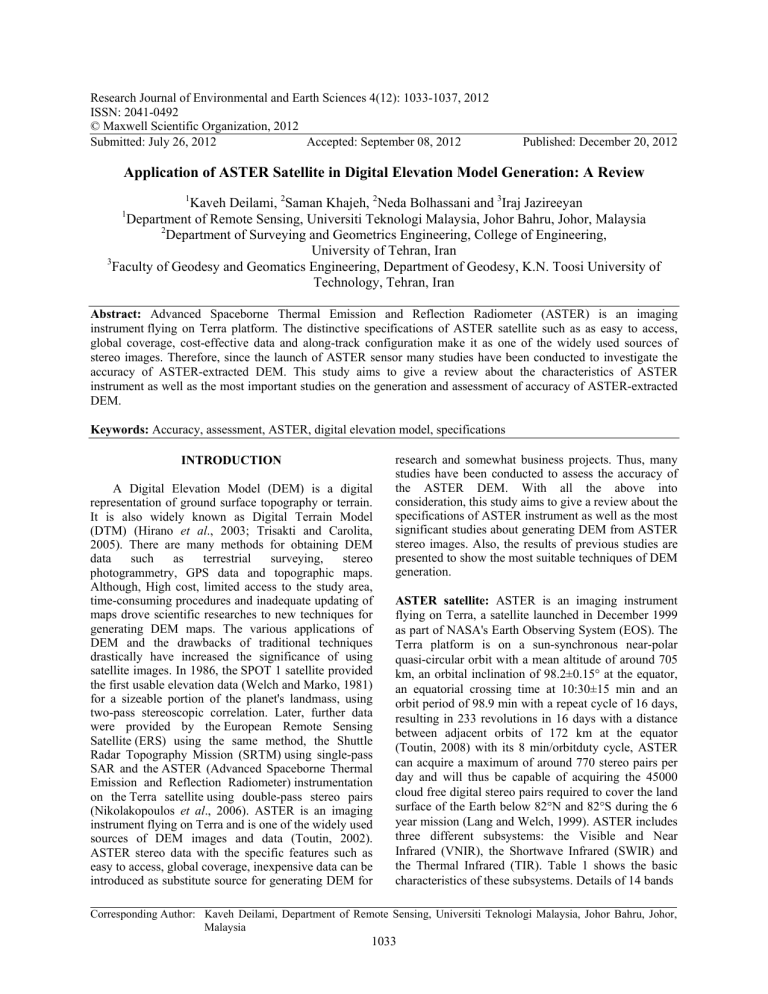
Research Journal of Environmental and Earth Sciences 4(12): 1033-1037, 2012 ISSN: 2041-0492 © Maxwell Scientific Organization, 2012 Submitted: July 26, 2012 Accepted: September 08, 2012 Published: December 20, 2012 Application of ASTER Satellite in Digital Elevation Model Generation: A Review 1 Kaveh Deilami, 2Saman Khajeh, 2Neda Bolhassani and 3Iraj Jazireeyan Department of Remote Sensing, Universiti Teknologi Malaysia, Johor Bahru, Johor, Malaysia 2 Department of Surveying and Geometrics Engineering, College of Engineering, University of Tehran, Iran 3 Faculty of Geodesy and Geomatics Engineering, Department of Geodesy, K.N. Toosi University of Technology, Tehran, Iran 1 Abstract: Advanced Spaceborne Thermal Emission and Reflection Radiometer (ASTER) is an imaging instrument flying on Terra platform. The distinctive specifications of ASTER satellite such as as easy to access, global coverage, cost-effective data and along-track configuration make it as one of the widely used sources of stereo images. Therefore, since the launch of ASTER sensor many studies have been conducted to investigate the accuracy of ASTER-extracted DEM. This study aims to give a review about the characteristics of ASTER instrument as well as the most important studies on the generation and assessment of accuracy of ASTER-extracted DEM. Keywords: Accuracy, assessment, ASTER, digital elevation model, specifications INTRODUCTION A Digital Elevation Model (DEM) is a digital representation of ground surface topography or terrain. It is also widely known as Digital Terrain Model (DTM) (Hirano et al., 2003; Trisakti and Carolita, 2005). There are many methods for obtaining DEM data such as terrestrial surveying, stereo photogrammetry, GPS data and topographic maps. Although, High cost, limited access to the study area, time-consuming procedures and inadequate updating of maps drove scientific researches to new techniques for generating DEM maps. The various applications of DEM and the drawbacks of traditional techniques drastically have increased the significance of using satellite images. In 1986, the SPOT 1 satellite provided the first usable elevation data (Welch and Marko, 1981) for a sizeable portion of the planet's landmass, using two-pass stereoscopic correlation. Later, further data were provided by the European Remote Sensing Satellite (ERS) using the same method, the Shuttle Radar Topography Mission (SRTM) using single-pass SAR and the ASTER (Advanced Spaceborne Thermal Emission and Reflection Radiometer) instrumentation on the Terra satellite using double-pass stereo pairs (Nikolakopoulos et al., 2006). ASTER is an imaging instrument flying on Terra and is one of the widely used sources of DEM images and data (Toutin, 2002). ASTER stereo data with the specific features such as easy to access, global coverage, inexpensive data can be introduced as substitute source for generating DEM for research and somewhat business projects. Thus, many studies have been conducted to assess the accuracy of the ASTER DEM. With all the above into consideration, this study aims to give a review about the specifications of ASTER instrument as well as the most significant studies about generating DEM from ASTER stereo images. Also, the results of previous studies are presented to show the most suitable techniques of DEM generation. ASTER satellite: ASTER is an imaging instrument flying on Terra, a satellite launched in December 1999 as part of NASA's Earth Observing System (EOS). The Terra platform is on a sun-synchronous near-polar quasi-circular orbit with a mean altitude of around 705 km, an orbital inclination of 98.2±0.15° at the equator, an equatorial crossing time at 10:30±15 min and an orbit period of 98.9 min with a repeat cycle of 16 days, resulting in 233 revolutions in 16 days with a distance between adjacent orbits of 172 km at the equator (Toutin, 2008) with its 8 min/orbitduty cycle, ASTER can acquire a maximum of around 770 stereo pairs per day and will thus be capable of acquiring the 45000 cloud free digital stereo pairs required to cover the land surface of the Earth below 82°N and 82°S during the 6 year mission (Lang and Welch, 1999). ASTER includes three different subsystems: the Visible and Near Infrared (VNIR), the Shortwave Infrared (SWIR) and the Thermal Infrared (TIR). Table 1 shows the basic characteristics of these subsystems. Details of 14 bands Corresponding Author: Kaveh Deilami, Department of Remote Sensing, Universiti Teknologi Malaysia, Johor Bahru, Johor, Malaysia 1033 Res. J. Environ. Eartth Sci., 4(12): 1033-1037, 1 20112 Table 1: Speciifications of ASTER R instruments VNIR SWIR R Band 1: 0.52-00.60 µm Band 4: 1.600-1.700 µm Nadir looking Band 2: 0.63-00.69 µm Band 5: 2.145-2.185 µm Nadir looking Band 3: 0.76-00.86 µm Band 6: 2.185-2.225 µm Nadir looking (3N) Band 3: 0.76-00.86 µm Band 7: 2.235-2.285 µm Backward lookking (3B) Band 8: 2.295-2.365 µm TIR Band 10: 8.12558.475 µm Band 11: 8.47558.825 µm Band 12: 8.92559.275 µm Band 13: 10.25510.95 µm Band 14: 10.95511.65 µm Band 9: 2.360-2.430 µm Table 2: Bandds characteristics of o ASTER instrum ments Characteristiccs VNIR SW WIR Ground resoluution 15 m 30 m Data rate (Mbbits/sec) 62 23 ±24 ±8.555 Cross-track pointing p (deg.) Cross-track pointing p (km) ±318 ±1116 Swath width (km) 60 60 Detector typee Si PtSi-Si 8 8 Quantization (bits) TIR 90 m 4.2 ±8.55 ±1 60 HgCdTe 12 in the vissible and infrrared spectrum m with differeent spatial resoolutions (VNIR R at 15 m, SW WIR at 30 m, TIR T at 90 m) arre given in Tab ble 2 (Fujisada,, 1994). ASTER stereoimaging s specification ns: The ASTE ER stereo subsystem is in fact f an implem mentation of the t Mapsat conceept to acquire global sterreo Stereosat-M coverage of o the land usin ng along-track digital sensorss in order to produce p globaal DEMs from m principles of photogram mmetry (Colvo ocoresses, 19882). The VN NIR subsystem is the only y one that provides sterreo o two indepeendent telescoope capability. It consists of t assembliess to minimizze image distortion in the backward- and nadir-lo ooking telescoopes (Yamagucchi et al., 19998). The focall plane of thee nadir telescoope contains thhree silicon Ch harge-Coupled Detector (CC CD) line arrays (bands 1, 2 an nd 3N of Tabble 1) while thhe p of the backward b telesscope has onlly one focal plane band (33B). The two im mages, 3N (Naadir looking) and a 3B (Backw ward looking),, generate ann along-track stereo pairs with w a Base-to-Height (B/H)) ratio of abouut 0.6. Since the t two telescoopes for the VN NIR sensor caan also be rotaated by ±24° too provide an extensive e crosss-track pointinng capability and a 5 dayy revisit capaability, across-track multi-ddate stereo im maging with better stereo geometry andd B/H ratios (closer to onne) is therefore possible. However, the saame-date alongg-track solutionn, even withh a worse stereo geomettry, is preferreed to the multti-date across-ttrack solution with w a better stereo s geometrry for the scienntific and operaational reasonss, due to thee strong advanntages in term ms of radiom metric variatioons (Toutin and Cheng, 2002) (Fig. 1)). Thhe ASTER im mage level-1A is used to prroduce DEM which contaains reconstruucted, unproccessed ment digital data d derived from f the teleemetry instrum streamss of the 3 teelescopes: Vissible Near Innfrared (VNIR)), Shortwave Infrared (SW WIR) and Thhermal Infraredd (TIR). Datta derived frrom each of these telescoppes or sensorrs are at threee different ground g resolutiions: VNIR att 15 m, SWIR at 30 m and TIR T at 90 m. These T depackeetized, demultipplexed and reaaligned instrum ment image datta have their geometric g corrrection coefficiients and raddiometric caliibration coeffi ficients calculaated and appeended but nott applied. Levvel-1A datasets also include corrections for the SWIR paarallax mation. and inttra- and inter-ttelescope regisstration inform ASTER R Level-1A daata is producedd at the Groundd Data System m (GDS) in Tookyo, Japan annd sent to the EROS E Data Centre’s (EDC) Distributed Acctive Archive Centre C C) for archiviing, distributioon and higherr-level (DAAC processsing. Fig. 1: Conffiguration of cap pturing stereo im mages by ASTER R (Toutin, 2002) 1034 Res. J. Environ. Earth Sci., 4(12): 1033-1037, 2012 LITERATURE REVIEW The theoretical accuracy of ASTER DEM is influenced by different parameters, i.e., Ground Control Points (GCPs), Base-to-Height (B/H) ratio and the method of image matching. When GCPs are not available the output DEM is relative and its accuracy is determined by Base-to-Height (B/H) ratio and the method of image matching (Toutin, 2008). In addition, the types of the terrain of the study area, geometric pattern, the accuracy of ephemeris and attitude data are crucial for accuracy of relative DEM. The design specifications of relative DEM of ASTER stereo images released the accuracy of order of 12-25 m or better while the absolute DEM with 4 GCPs shows the accuracy between 7-30 m (Lang and Welch, 1999). In the case of absolute DEM, the accuracy is-governed by the number and distribution of GCPs which are used to either compute the geometric modeling (indirect dereferencing) or to tie the DEM to coordinate system or datum of interest. However, the errors of the GCPs can escalate the propagation of errors in the final DEM. Therefore, the accuracy of the control data should be at least twice more accurate than the expected final DEM. For instance, in order to achieve the 12-25 m accuracy from ASTER absolute DEM, 1:50,000 or smaller scale of topographic maps with at least 10 m accuracy can be used (Toutin, 2008). In order to verify the pre-launch specifications of ASTER DEM (Welch et al., 1998) used the SPOT High Resolution Visible (SPOT-HRV) stereo data to produce the simulation of ASTER stereo data with 15 m resolution. Consequently, the DEM was generated with 30 m resolution. The assessment of accuracy was carried out by comparison between the 63 check points from DEM and United States Geological Survey (USGS) 7.5 min. Therefore, an accuracy of 13 m was obtained. Besides, the same simulations studies have been done on mountainous Japanese and French sites by Arai (1992) and Dowman and Neto (1994), respectively where similar results were achieved. In addition, the along-track stereo data of Japan Earth Resources Satellite Optical Senor (JERS-1 OPS) was used to produce simulated ASTER stereo data and correspondent DEM. The evaluation of accuracy was conducted by using the check points from 1:25 000 topographic maps which yielded the RMSE of 12 m (Tokunaga et al., 1996). The other parts of the studies are related to the assessment of accuracy of real ASTER stereo images by utilizing different off-theshelf software. The most used software for generating ASTER DEM is listed as follows (Toutin, 2008): GeomaticaTM Ortho EngineSE of PCI Geomatics (www.pcigeomatics.com) Ortho Base Pro module of ERDAS ImagineH and the LPS SP 2 of Leica Geo systems Geospatial Imaging (www.gis.leica-geosystems.com) ENVI DEM Extraction Module of ENVI 4.7 (www.rsinc.com) Desktop Mapping System (DMS)TM of R-WEL (www.rwel.com) AsterDTM module. (http://www.envi.com.br/ asterdtm) According to the literatures, Ortho Engine of PCI Geomatica which employed the Toutin’s model is the most favorite software (Kaab, 2002; Toutin, 2002; Chrysoulakis et al., 2004; Cuartero et al., 2004, 2005a; Eckert et al., 2005). Toutin’s model is a rigorous model developed by Dr. Toutin at the Canada Center for Remote Sensing to compensate for distortions; such as sensor geometry, satellite orbit, attitude variations, earth shape, rotation and relief. However, the model cannot be applied when only a portion of image is used, the image has been geometrically corrected or there is no ephemeris data. The Ortho Engine tool offers the generation of either absolute or relative DEM. The extracted DEM by using the PCI Geomatica mostly gave the accuracy of ±15 and ±15-25 m in horizontal and vertical direction, respectively which are dependent on the relief of the study area, number and distribution of applied GCPs. In comparison to PCI Geomatica the ERDAS Imagine showed weaker results. The most important problem is the absence of specific model for processing ASTER level 1A stereo data. The above problem was verified by Cuartero et al. (2004) by generating DEM from 55 stereo data in which the results showed the RMSEz of ±34.8 m. Besides, Trisakti and Carolita (2005) achieved somewhat better results (±27 m). In order to solve this problem, the LPS SP 2 in Leica Geosystems Geospatial Imaging was presented by ERDAS but the same results were achieved by using ASTER Level 1A stereo images (Cuartero et al., 2005a). Apart from above software, ENVI is one the most used software which employs the RPC model to generate the ASTER DEM. A 9-steps user-friendly wizard is offered to produce the DEM. The software allows stepping forward and backward as well as collecting the tie points manually or automatically. ENVI 4.1 was used to produce DEM with 15×15 m resample spacing in a 43 km long and 50 km wide area from ASTER level1B images by Lee et al. (2008) in Geyeongsagbukdos (Korea). Finally the accuracy was estimated by using comparing transects from elaborated DEM and referenced digital topographic maps of 1:25000 scales. The Results indicated that RMSE in elevation between ±7 and ±20 m could be achieved. Desktop Mapping System (DMS) is popular software in mapping. Hirano et al. (2003) assessed the accuracy of ASTER DEM for four study sites on Japan, Chile and USA by using DMS. The accuracy of the DEMs were evaluated by comparing the Z-values 1035 Res. J. Environ. Earth Sci., 4(12): 1033-1037, 2012 (check points) from DEMs and corresponding points from topographic maps. Results indicated that a RootMean-Square Error (RMSE) in elevation between ±7 and ±15 m can be achieved with ASTER stereo image data of good quality. Furthermore, Aster DTM module, developed by SulSoft who are the exclusive ENVI distributors in Brazil, is a new add-on module to ENVI, which allows DEMs to be quickly created only from ASTER level 1A and 1B stereo pairs (www.envi.com. br/asterdtm/english/). Therefore, both absolute and relative DEMs can be generated. Aster DTM converts the stereo images into a pair of quasi-epipolar images that have a pixel displacement in the satellite flight direction proportional to the pixel elevation. A crosscorrelation method is then used to evaluate this displacement and transform it into elevation values. An existing DEM can be added in the process to fill in areas where the correlation values are too low. Automatic detection of water bodies was recently added and water pixels forming large water bodies (lake, reservoirs, sea, etc.) are now automatically assigned the mean elevation value of the borderline (Toutin, 2008). Studies which have been conducted by Cuartero et al. (2005b) yielded an error of almost 17 m with 90% level of confidence by utilizing Aster DTM module. In addition to the above studies which specifically covered the assessment of accuracy of ASTERextracted DEM, there are other studies which investigated the application of ASTER DEM in geosciences. ASTER images were used to produce DEM of Taranaki volcano in North Island of New Zealand by Stevens et al. (2004). In order to determine the relative offset between each pixel and the same pixel on the earth, the nadir and aft images were compared manually. Consequently, an iterative, 4-step approach for matching method was used. Rough offset between the nadir and aft views (bands 3N and 3B) for each pixel was calculated and then refined and finetuned. This was achieved by selecting tie-points common in both images, generating a polynomial (usually of degree 1) to relate nadir coordinates to aft coordinates and resample the aft scene in nadir space based on this polynomial. A frequency domain crosscorrelation was then used to estimate the offset between images at each pixel using a roving kernel, or window of pixels, starting with a kernel of 16×16 pixels. The cross-Correlation (Corr) of a kernel in the nadir (n) and the aft (a) is given by the relation Eq. (1): Corr (n, a) = IFFT (NA*) (1) where, N & A : The two-dimensional Fourier transforms of n and a * : The complex conjugate of the transform IFFT : The Inverse Fast Fourier Transform The maximum value in the resulting Corr (n, a) array is the maximum correlation and the location within the array provides the offset between aft and nadir images at the Kernel location. The kernel size was then decreased successively to 8×16 pixels, 8×8 and 4×8. Each time the kernel size was reduced, the offset was updated by combining the offset and the lag from the new correlation. Inspection of the offset array reveals a significant number of spikes or high frequency noise, which was reduced using a median filter (which preserves correlation peaks). After the 8×8 kernel stage, the final offset is an integer value. In the final operation, the kernel size is reduced to 4 samples by 8 lines and a polynomial interpolation on the resulting correlation matrix provides a fractional value for the lag position. This is the final match position. The relative Height (∆H) of a feature on the landscape is then derived by the relationship Eq. (2): ∆H ∆X/∅ (2) where, ∆X : The parallax or final match offset ∅ : The intersection angle As the image matching method used a ‘‘kernel’’ operation, the exact parallax at any point was not calculated, but instead an average parallax for the kernel was derived and the resulting calculated values of height were essentially smoothed. Besides, ASTER DEMs of Taranaki volcano were dereferenced initially to geographic map coordinates using the supplied ASTER header data and then refined using known survey trig points identifiable in the false color composite imagery derived from bands 1, 2 and 3N of the nadir image. Comparison of the ASTER DEMs with Land Information New Zealand (LINZ) digitized data and with surface features in the georeferenced TOPSAR DEMs indicated that the ASTER data were georeferenced to within subpixel accuracy (<15 m) by this method. The trig points were also used to refine the vertical scaling of the ASTER DEMs interactively, as well as using the assumption that the coastline has zero elevation, in the case of the DEM of Taranaki. CONCLUSION The various applications of DEM and the drawbacks of traditional techniques drastically have increased the significance of using satellite images. Remote sensing has become an essential and universal tool to produce DEM and 3D images in many areas.The special characteristics of ASTER stereo images such as world-wide coverage, along-track configuration and easy access make them valuable for DEM generation for various applications. Therefore, since the launch of 1036 Res. J. Environ. Earth Sci., 4(12): 1033-1037, 2012 ASTER sensor many studies have been conducted to investigate the accuracy of ASTER-extracted DEM. The studies can be divided into two groups; first the pre-launch or simulated studies which showed the expected accuracy of ASTER DEM between ±7 and ±20 m; second the studies with real ASTER stereo data. Most of the studies with the real ASTER stereo images have been carried out on mountainous areas by utilizing various software such as PCI Geomatica, ERDAS and ENVI. The results showed the accuracy is depended on the employed software, type of the terrain and numbers and distribution of GCPs in the case of absolute DEM. REFERENCES Arai, K., 1992. Accuracy assessment of DEM with EOSa/ASTER. Unpublished Report to the ASTER DEM Working Group, Department of Information Science, Saga University, Japan, pp: 9. Chrysoulakis, N., M. Abrams, H. Feidas and D. Velianitis, 2004. Analysis of ASTER Multispectral Stereo Imagery to Produce Dem and Land Cover Databases for Greek Islands: The REALDEMS Project. In: Prastacos, P., U. Cortes, J.L. De Lean and M. Murillo (Eds.), Proceeding of e-Environment: Progress and Challege, pp: 411-424. Colvocoresses, A.P., 1982. An automated mapping satellite system (Mapsat). Photogramm. Eng. Rem. S., 48: 1585-1591. Cuartero, A., A.M. Felici'Simo and F.J. Ariza, 2004. Accuracy of DEM generation from TERRAASTER stereo data. Int. Arch. Photogramm. Rem. S., 35(B2): 559-563. Cuartero, A., A.M. Felicisimo and F.J. Ariza, 2005a. Accuracy, reliability and depuration of SPOT HRV and Terra ASTER digital elevation models. IEEE T. Geosci. Remote, 43: 404-407. Cuartero, A., E. Quiros and A.M. Felici' Simo, 2005b. A Study of ASTER DEM Accuracies and its Dependence of Software Processing. Proceedings of 6th International Conference on Geomorphology, Zaragoza, Spain, Retrieved from: www.unex.es/eweb/kraken/pdf/6 Geom_05.pdf, (Accessed on: January 07, 2012). Dowman, I. and F. Neto, 1994. The accuracy of alongtrack stereoscopic data for mapping: Results from simulations and JERS OPS. Int. Arch. Photogramm. Rem. S., 30: 216-221. Eckert, S., T. Kellenberger and K. Itten, 2005. Accuracy assessment of automatically derived digital elevation models from ASTER data in mountainous terrain. ISPRS J. Photogramm. Remote Sens., 26: 1943-1957. Fujisada, H., 1994. Overview of ASTER instrument on EOS-AM1 platform. Proceedings of SPIE, 2268: 14-36. Hirano, A., R. Welch and H. Lang, 2003. Mapping from ASTER stereo image data: DEM validation and accuracy assessment. ISPRS J. Photogramm. Remote Sens., 57: 356-370. Kaab, A., 2002. Monitoring high-mountains terrain deformation from air-and spaceborne optical data. ISPRS J. Photogramm. Remote Sens., 57: 39-52. Lang, H. and R. Welch, 1999. Algorithm Theoretical Basis Document for ASTER Digital Elevation Models. Version 3.0, Jet Propulsion Laboratory, Pasadena, CA, pp: 69. Lee, J., H.B. Seung-Hee, L.C. Sung-Soon and P. JinSung, 2008. Correcting DEM extracted from ASTER stereo images by combining cartographic DEM. Int. Arch. Photogramm. Remote Sens. Spatial Inform. Sci., 37(Part B1): 829-834. Nikolakopoulos, K.G., E.K. Kamaratakis and N. Chrysoulakis, 2006. SRTM vs ASTER elevation products: Comparison for two regions in Crete, Greece. Int. J. Remote Sens., 27(21): 4819-4838. Stevens, N.F., H. Garbeil and J.P. Mouginis-Mark, 2004. NASA EOS ASTER: Volcanic topographic mapping and capability. Remote Sens. Env., 90: 405-414. Tokunaga, M., S. Hara, Y. Miyazaki and M. Kaku, 1996. Overview of DEM product generated by using ASTER data. Int. Arch. Photogramm. Remote Sens., 31(B4): 874-878. Toutin, T., 2002. 3D topographic mapping with ASTER stereo data in rugged topography. IEEE T. Geosci. Remote Sens., 40: 2241-2247. Toutin, T., 2008. ASTER DEMs for geometric and geoscientific applications: A review. Int. J. Remote Sens., 29(7): 1855-1875. Toutin, T. and P. Cheng, 2002. Comparison of automated digital elevation model extraction results using along-track ASTER and across-track SPOT stereo images. Opt. Eng., 4: 2102-2106. Trisakti, B. and I. Carolita, 2005. Comparison result of DEM generated from ASTER stereo data and SRTM. Proceedings of Map Asia, GIS Development, Aug. 22-25, Jakarta (CD-ROM). Welch, R. and W. Marko, 1981. Cartographic potential of spacecraft line-array camera system: Stereosat. Photogramm. Eng. Rem. S., 47(8): 1173-1185. Welch, R., T. Jordan, H. Lang and H. Murakani, 1998. ASTER as a source for topographic data in the late 1990s. IEEE T. Geosci. Remote Sens., 36: 1282-1289. Yamaguchi, Y., A. Kahle, H. Tsu, T. Kawakami and M. Pniel, 1998. Overview of Advanced Spaceborne Thermal Emission and Reflection Radiometer (ASTER). IEEE T. Geosci. Remote Sens., 36: 1062-1071. 1037
